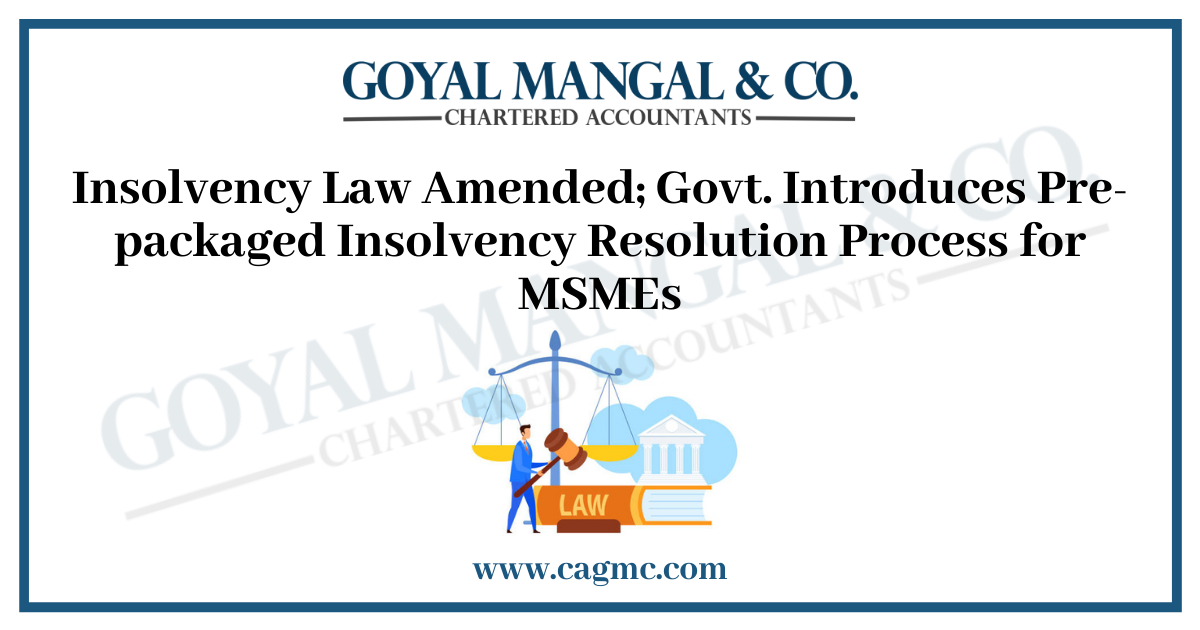
On 4th April 2021, the Centre issued an ordinance to introduce pre-packaged insolvency for corporates classified as MSMEs. The Pre-Package Insolvency Resolution Process is aimed at reviving MSMEs by submitting Base Resolution Plan along with the other data by the MSME itself.
Since MSMEs are pretty critical for the economy of India, the government considered it a right fit to first introduce pre-packs for MSMEs. Besides offering employment to the country’s sizeable population, MSMEs contribute hugely to India’s GDP (Gross Domestic Product).
Moreover, during the current pandemic, the MSME in India has suffered the most than others. In fact, with the threshold of a debt default at ₹ 1 crore now under IBC, maximum MSMEs are out of this scope. In the upcoming days, the Centre is supposed to notify the debt default threshold for MSMEs for which the pre-packs could be used.
This ordinance is supposed to offer relief and a new lease to the companies whose fate was earlier dependent upon various debt restructuring schemes in the past.
Currently, there are about 6-7 lakh companies in India that fall under the category of MSMEs (Micro, Small and Medium Enterprises). Potentially, many of these companies could avail benefits from the newly introduced pre-packaged insolvency framework.
But before we dig deeper into that actual ordinance, it’s important to understand- what is the Pre-Packaged Insolvency resolution process and what are its general characteristics?
So, without any further ado, let’s get started-
What is the Pre-Packaged Insolvency Resolution Process?
In the Indian context, the Pre-packaged insolvency resolution process (also known as PPIRP), is a substitute to the Corporate Insolvency Resolution Process (CIRP), prescribed by Insolvency and Bankruptcy Code, 2016.
Technically, it’s a process where the business resolution is negotiated with a buyer before the appointment of an insolvency professional.
In other terms, pre-packs are an amalgamation of formal and informal mechanisms where the informal process extends to NCLT admission.
As specified under the Insolvency and Bankruptcy Code (IBC), the NCLT admission is followed by the existing NCLT supervised process for resolution.
One of the significant aspects of current pre-packs is that it is significantly inexpensive and less time-consuming as compared to the formal insolvency proceedings.
Features of General PPIRP
A General Pre-packaged insolvency resolution process has the following characteristics:
- Pre-pack is the resolution process of the distressed company’s debt through a contract between investors and creditors, instead of a public bidding process.
- Pre-packaged Insolvency is a quasi-formal arrangement that blends the essence of a formal bankruptcy and that of an out-of-court private restructuring.
- It is based on the consent of both creditor and defaulting debtors where both of them agree to reform the business or entity.
- It may have a pre-approved pre-packaged resolution plan (refer to as “Base resolution plan) agreed between creditor and debtor.
- The Pre-pack is formulated for a special category of entities or sectors with a goal of restructuring/reforming them.
- It could be a pre-planned insolvency process where a resolution plan is constructed and concluded before starting the formal proceedings.
Highlights of the Pre-Pack Ordinance
Following are the highlights of the newly introduced ordinance:
- To deal with the pre-packaged insolvency resolution process, Chapter IIIA has been introduced in the IBC on 04.04.2021. Subjected to several conditions as specified in Section 54A, a Corporate Applicant with the Adjudicating Authority in respect of MSME (Corporate Debtor) can file an application for the initiation of a pre-packed insolvency resolution.
- The provisions of Pre-pack insolvency for MSMEs shall not be applied to filed and pending applications under Section 7,9, or 10 of IBC as on the date of the ordinance, 2021.
If the application to initiate the PPIRP is pending in terms of Section 54C, the Adjudicating Authority shall admit or reject Section 54C on priority considering any application filed under Section 7,9, or 10 of IBC.
If the application under Section 54C is made within 14 days of any pending application filed under Section 7, 9 or 10, then under Section 54C, the Adjudicating Authority must dispose of it. However, if the application is filed after 14 days from the application filed under Section 7,9, or 10, the Adjudicating Authority shall dispose of it under the same section of the IBC.
- The Corporate Debtor must obtain approval of 66% from its Financial Creditors to file an application for initiation of pre-pack insolvency process in such a form as may be specified, not being its related parties. The MSMEs must complete PPIRP 120 days from the commencement date of the pre-pack insolvency.
- On the receipt of the application within 14 days, the Adjudicating Authority by order may admit or reject the application. Nevertheless, the authority must notify the applicant for rectifying the application within 7 days, before rejecting it.
- As prescribed under Section 14 of IBC, the Moratorium shall be mutatis mutandis apply to PPIRP for MSME. The Moratorium shall be available from the commencement date of the Pre-pack process until the process is closed. Unlike CIRP, the possession and control during the process lie with the present management and promoters of the MSMEs.
In case the Base Resolution Plan submitted by the existing management isn’t approved or if it doesn’t offer the full payment of the confirmed claims, the Resolution Professional shall invite prospective Resolution Applicants for submitting a Resolution Plan or compete with the Base Resolution Plan. Appeal against the order approving the Pre-pack process falls under Section 61(3) of the IBC.
- In case of any fraudulent conduct of the company or gross mismanagement and where there is the termination of PPIRP, the Adjudicating Authority may pass an order of liquidation.
To know the Pre-pack process, first, have a look at the eligibility criteria of the entities entitled to file an application for PPIRP:
Pre-requisites for Filing Application for PPIRP
- To propose and approve the name of the IP (Insolvency Professional) to be appointed as Resolution Professional to conduct PPRIP, the Financial Creditors (FC) of the Corporate Debtors, not being its related parties, must represent 66% in value of financial debt.
- The majority of the Directors /Partners of Corporate Debtors to declare in Form P6/P7 stating-
Only Micro, Small and Medium Enterprises are eligible for the PPIRP.
Eligibility of Corporate Debtors (MSMEs) to Initiate the PPIRP
- The CD hasn’t undergone PPIRP or completed CIRP, as the case may be, during the timeframe of 3 years preceding the date of application to initiate PPIRP;
- CD is not undergoing CIRP;
- No order for liquidation of CD is passed;
- CD is eligible to submit a Resolution Plan under section 29A of IBC;
- The Financial Creditors must have proposed an IP and approved (with 66% voting by the value of financial debt) the person to act as Resolution Professional for conducting PPIRP
- That the CD must make an application to initiate PPIRP within a specific time period not exceeding 90 days;
- That the PPIRP is not being instated to deceive any person; and
- The name of the Resolution Professional proposed and approved by FC/OC or person as may be specified. Insolvency Professional (IP) proposed and approved to be appointed as RP under Section 54A(e).
Entities Not Entitled to File an Application
The following entities aren’t eligible to make an application to initiate PPIRP:
- A Corporate Debtor who is undergoing a CIRP or PPIRP; or
- A Financial Creditor (FC) or an Operational Creditor(OC) of CD who is undergoing PPIRP; or
- A CD in respect of whom a Resolution Plan has been approved under Chapter III-A (PPIRP) 12 months preceding the date of filing the application; or
- A CD or an FC who has violated any of the terms of the Resolution Plan which was approved 12 months prior to the date of filing a PPIRP application; or
- A Corporate Debtor in respect of whom a liquidation order has been issued.
Pre-Packaged Insolvency Resolution Process for MSMEs
Have a look at the Pre-packaged Insolvency Resolution Process of MSMEs:
Step 1: Invitation for Resolution Plans
A resolution plan must offer the measures, as may be required, for maximising its assets’ value. It must contain the mandatory contents of the plan.
Step 2: Submission of Resolution Plans
The applicant needs to submit the resolution plan/(s) in accordance with the Code and these Regulations to the Resolution Professional electronically within the stipulated time provided in the invitation for the plan.
A resolution plan not complying with the provisions of sub-regulation (1) shall be rejected.
Step 3: Evaluation of Resolution Plans
The resolution plans received under regulation 46 complying with the requirement of the code and these regulations, shall be assessed on the basis for evaluation.
The resolution plan receiving the highest score under sub-regulation (1) shall be chosen for competition with the base resolution plan.
Step 4: Approval of Resolution Plan
The resolution plan selected under regulation 47 shall be approved if it is significantly better than the base resolution plan.
Step 5: Application to the Adjudicating Authority
- Once the committee has approved the resolution plan, the resolution professional needs to submit an application to the Adjudicating Authority, along with a compliance certificate in Form P12, for approval.
- The resolution professional shall instantly send a copy of the order of the Adjudicating Authority approving or rejecting a resolution plan to the participants and the resolution applicant.
- The resolution professional must intimate each claimant within seven days of the order of the Adjudicating Authority approving a resolution plan, the principle or formula, as the case may be, for payment of debts under such resolution plan.
- If the committee hasn’t approved the resolution plan, the resolution professional must file an application in Form P13 to the Adjudicating Authority for closing the process.
A Debtor in Possession Model
The framework in the process is kind of an experiment and differs in some ways from the regular CIRP.
Unlike CIRP, this pre-pack framework for MSMEs will be a creditor in control and a debtor in possession model. However, in the case of CIRP, it was the creditor in control and professional in possession.
In simpler terms, the current Pre-packs will allow the debtor to continue to control and operate the enterprise until resolution takes place.
In an interview, Chairperson, Insolvency and Bankruptcy Board of India (IBBI), M.S. Sahoo said-
“The objective of introducing pre-packs for MSMEs is to quicken the process for MSMEs’ resolution and it’s a cost-effective mechanism. The pre-pack for MSMEs depends on the debtor in possession model, unlike the regular CIRP where RP is in possession. This is supposed to offer various flexibilities to existing promoters of MSMEs.”
Experts’ Take on the Current Pre-Pack Ordinance
According to Rajiv Chandak, Partner, Deloitte India-
“The government has currently restricted Pre-packs provisions for MSMEs and in some time, it will extend it to other corporations as well. It will aid Corporate Debtors to enter into consensual restructuring with lenders and address the company’s liability side. The government has to further augment the NCLT’s infra so that Pre-packs can be employed in a time-bound manner. The government must also consider establishing certain benches looking at Pre-Pack and Insolvency above a certain size to promote resolution of large cases within a stipulated timeframe.”
Partner, J Sagar Associates, Soumitra Majumdar said-
“As with any legislation, this Ordinance is also ought to emerge, because it goes along to address implementation troubles which will arise. Illustratively, the payment/ restructuring terms to dissenting creditors may have to be handled soon, particularly in light of the recent Supreme Court judgement.”
Key Takeaways
Clearly, the Pre-packaged insolvency resolution process for MSME has led to a drastic turnaround in the corporate distress resolution framework of India. It has completely fortified the Indian Insolvency Resolution Framework.
While the Pre-pack process is currently restricted to MSMEs, the government is planning to roll it out for other corporates as well. Moreover, while drafting the Pre-pack scheme for other organizations, the success and the failures of the MSME Pre-pack should be considered.
Pre-packs pre-supposes co-operation among distinct classes of creditors and debtors to work efficiently. The success of Pre Packs is directly correlated to the role played by the participants of the process- Financial Creditor, Adjudicating Authority, Management, and Resolution Professional.
Rest, we need to wait and watch what good this ordinance will really do. Will it really achieve its objective? We hope it does.
Until then, stay tuned with us!


